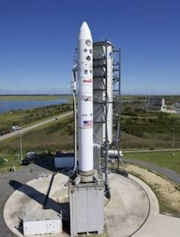By James A. Bacon
The world of space junkies can be divided into three camps: those who think the United States should pursue a Mars first policy, those who think it should pursue a Moon first policy, and the killjoys who think all that human exploration is a waste of money and time. I belong to the Moon camp on the grounds that, as human economic and military activity expands into space, the Moon can provide a viable platform.
Humans already use space for weather, military, scientific and telecommunications satellites. Space tourism is taking off. It’s only a matter of time before space becomes weaponized — some futurists envision orbiting battle stations — and before we launch vast orbiting solar-energy collectors. It’s also possible that we will find space to be the preferable environment for manufacturing processes that require zero gravity or perfect vacuums. The great hurdle is the incredibly high cost of overcoming Earth’s gravity well. The Moon, with its much weaker gravity well, would be a preferable location from which to service all that activity. Additionally, the Moon is an abundant source of Helium-3, considered an ideal fuel for nuclear fusion. If and when mankind masters nuclear fusion, the Moon will become the first celestial Yukon. Looking ahead 50 or 60 years, it is possible to imagine lunar colonies entering the nexus of mankind’s economic, military and political affairs in a way that Mars never could.
That’s why I’m totally stoked by news that NASA is launching a robotic spacecraft, LADEE, from Wallops Island tonight. LADEE (Lunar Atmosphere and Dust Environment Explorer) will be the first spacecraft launched from Wallops. Its mission is to examine the minimal traces of lunar atmosphere and, far more importantly from a practical standpoint, the phenomenon of lunar dust.
Apollo Astronauts who walked on the Moon observed a glow on the lunar horizon, likely caused by sunlight reflecting off dust levitated by electrostatic forces. After being pounded for billions of years by meteorites and micro-meteorites, the lunar surface is carpeted by finely pulverized dust. There is a concern that dust, attracted by its electrostatic properties to metal, could foul mechanical equipment operating on the Moon. Dust, in a word, could be to the Moon was rust is to Earth. Thus, it is a phenomenon worthy of study not only for scientific reasons but for practical ones.
Adding to the coolness factor of this launch, LADEE will ride aboard a Minotaur rocket manufactured by Orbital Sciences, a Virginia company. So, if you see a speck of light moving rapidly across the sky tonight, hoist a mug (or wine glass, or non-alcholic beverage of your choice) to the LADEE and the minotaur.



